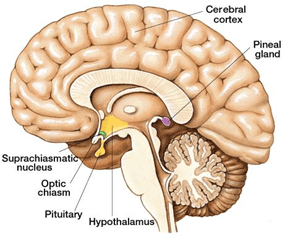Difference Between Pituitary and Pineal Gland
In general, there are two types of glands in our body. The first type is the duct glands that release their secretions out through the ducts into some hollow organ s; like the salivary glands of the mouth and gastric glands of the stomach. The second type of glands does not have ducts, but release their secretions directly into the bloodstream, which carries the secretion to their effective place elsewhere. The second type is commonly referred to as ‘ ductless glands ’, and their secretions are called hormones . The main ductless glands in the body are pituitary, pineal, gonads (testicles in the male and ovaries in the female), thymus, pancreas , thyroid, parathyroid , and adrenal glands. Out of these glands, the pineal glands and pituitary glands are neuroendocrine glands, which contain neuroendocrine cells and are located in the brain. These cells are related to nerve and sensory cells, and do not release their neurotransmitters at synapses , but secrete them directly into the blood as hormones.

Pituitary gland is located at the base of the brain posterior to the optic chiasm and is attached to the hypothalamus by a small stalk. It is known as a compound endocrine gland because of its microscopic structure. Pituitary is composed of two parts; namely, anterior pituitary and posterior pituitary. These two parts differ in many ways including their secretion hormones, embryonic origins etc. (Read more: Difference Between Anterior Pituitary and Posterior Pituitary)
The posterior pituitary gland secretes two hormones; antidiuretic hormone (ADH), which stimulates the reabsorption of water from urine, and oxytocin, which stimulates the contractions of uterus and milk ejection in the mammary glands. The anterior pituitary gland secretes seven hormones; namely, adrenocorticotropic hormone (ACTH), melanocyte- stimulating hormone (MSH), growth hormone (GH), prolactin (PRL), thyroid- stimulating hormone (TSH), luteinizing hormone (LH), and follicle- stimulating hormone (FSH).
Pineal gland is located in the roof of the third ventricle of the brain in many vertebrates. The gland is pinecone-shaped and about the size of a pea, which gives it its name. Pineal gland is evolved from a medial light- sensitive eye in primitive vertebrates. It is still present in some primitive fish and some modern reptiles. However, in other vertebrates, it is buried in the brain acting as an endocrine gland. Pineal gland secretes only the Melatonin hormone, which is a derivative of amino acid. The secretion of melatonin is regulated by the hypothalamus, and the secretion is activated in the dark. Gonds, brain, and pigment cells are the effective places of melatonin. Melatonin mainly regulates the biological rhythms by increasing its concentration in blood during night time and decreasing the same during day time. In addition, it helps to regulate reproductive cycles in some vertebrates.
What is the difference between Pituitary and Pineal Glands?
• Pituitary gland is located at the base of the brain and is attached to hypothalamus by a small stalk, whereas pineal gland is located in the roof of the third ventricle of the brain.
• Unlike the pineal gland, pituitary gland is composed of two parts.
• Pituitary gland secretes nine hormones while pineal gland secretes only one hormone.
• Pineal gland helps to regulate biological rhythms, whereas pituitary gland helps to regulate many biological processes such as growth, stimulating the secretion of other hormones, milk ejection, uterus contraction , ovulation, spermatogenesis etc.